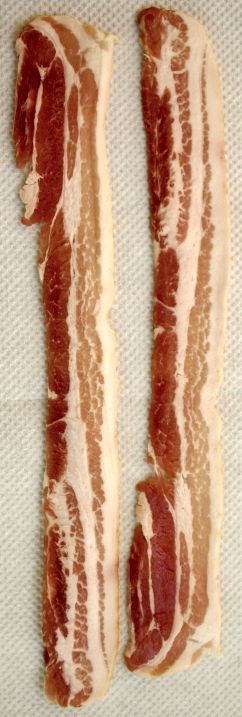
Everyone knows, that the way to a man’s heart is through his stomach. But the way to a man’s soul is through his nostrils. And only the sweet, smoky scent of cured pork will properly allow the journey.
I can say, with great confidence that the heavenly aroma of crackling strips of swine can melt the heart of even the most hardened vegetarian! It is true I have seen it! Brothers and sister’s there is hope for all ye who enter the meatless world of Vegetaria.
One cool autumn weekend, I had the pleasure of cooking for some friends. Our meal was to consist a late afternoon soup. And the foundation of that soup was one glorious pound of apple-wood smoked pork belly upon which a French lentil soup was to be built. Shallots would shed their bitter ego, vintage port would invigorate the timid lentils. Finally Roma tomatoes stewed and bloated with a velvety
 saffron-butter reduction were crowned with shaved fennel tossed with lemon and olive oil. The soft, dulcet tones of Getz and Gilberto lulled us into a euphoric stupor as we prepared this soup together in the late afternoon warmth of September. And so, as I always do, I taste. And offer tastes to those who surround me. There we were, dancing to the music, pillaging the pot of its crackling bacon bits, and I offered one to a lovely young lass, with a smile and soft olive skin. I expected a joyous sigh, a declaration of my masterful talents, and the wonder of bacon. And as if the entire interaction was in slow motion, she gasped, then furrowed her brow as if the smell made her sick. She shook her head, “no, no, no!” Refusing the meat, she stood there aggravated, “I’m a vegetarian, I don’t eat bacon. Ew!”
saffron-butter reduction were crowned with shaved fennel tossed with lemon and olive oil. The soft, dulcet tones of Getz and Gilberto lulled us into a euphoric stupor as we prepared this soup together in the late afternoon warmth of September. And so, as I always do, I taste. And offer tastes to those who surround me. There we were, dancing to the music, pillaging the pot of its crackling bacon bits, and I offered one to a lovely young lass, with a smile and soft olive skin. I expected a joyous sigh, a declaration of my masterful talents, and the wonder of bacon. And as if the entire interaction was in slow motion, she gasped, then furrowed her brow as if the smell made her sick. She shook her head, “no, no, no!” Refusing the meat, she stood there aggravated, “I’m a vegetarian, I don’t eat bacon. Ew!” Silence. My dear friends, silence. The kitchen quickly became a vacuum. A dark lifeless, voided space where no light could survive. Disappointed I turned my attention back to the soup. I tried to imagine a world without bacon, and it was impossible. So, I tried to imagine a world without vegetarians, which was much easier, and a smile crept its way back onto my face. Then I forgot all about the Vegetarian, as if she had never existed; as if she had run into my chef’s knife while I was cooking and bleed to death quietly in the corner. Then I imagined we hid the body down by the lake….and enjoyed every spoonful and bread soaked bite of our bacon filed soup.





